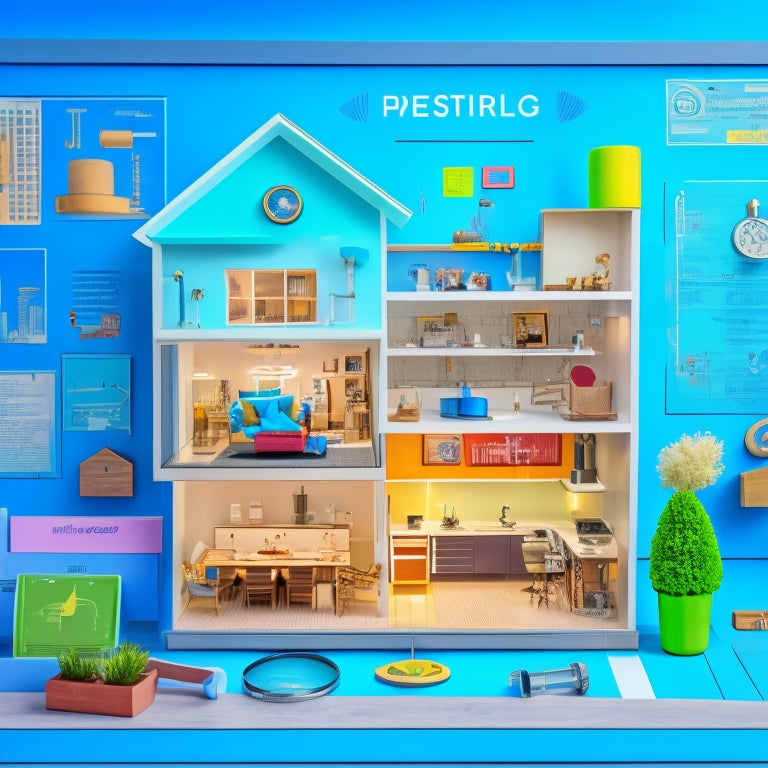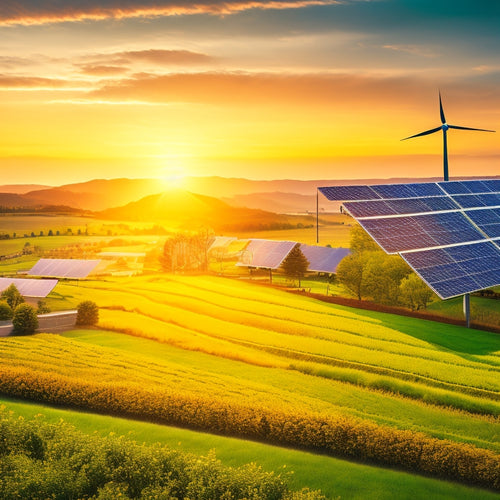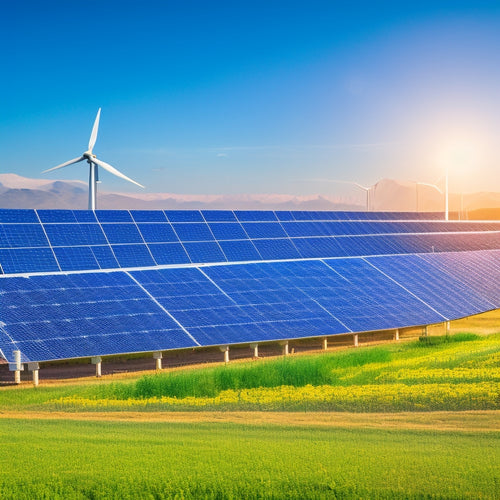
What's in a Home Energy Audit Checklist?
Share
As you prepare for a home energy audit, you'll want to know what's on the checklist. Expect a thorough review of your home's energy efficiency, including identifying energy-consuming appliances, inspecting insulation and ventilation systems, evaluating lighting and electrical systems, and evaluating water conservation opportunities. The audit will also identify air leaks and drafts, and provide prioritized energy-saving recommendations. From there, you'll uncover how to optimize your home's energy performance, and the benefits will become clear as you reveal opportunities to reduce energy consumption, lower utility bills, and contribute to a more sustainable future - and that's just the beginning.
Overview
- A home energy audit checklist includes assessing insulation and ventilation, inspecting lighting and electrical systems, and evaluating water conservation opportunities.
- It involves identifying energy-consuming appliances, detecting air leaks, and reviewing energy usage patterns to prioritize energy-saving recommendations.
- The checklist covers safety concerns, such as overloaded circuits and electrical panel sizing, to ensure a safe and efficient energy system.
- It also includes tools and technologies like blower door tests, thermal imaging, and data analysis software to gather accurate energy consumption data.
- The comprehensive checklist provides a roadmap for homeowners to achieve energy efficiency, reduce utility bills, and enhance indoor air quality and comfort.
Understanding Energy Efficiency Goals
When it comes to conducting a home energy audit, you likely have one primary goal in mind: to reduce your energy consumption and lower your utility bills.
You want to live more sustainably and minimize your environmental footprint. To achieve this, you'll need to identify energy-intensive appliances like refrigerators and air conditioners, and determine individual energy consumption rates in watts and usage hours.
This might involve sealing air leaks, adding insulation, or upgrading to energy-efficient appliances. By taking these steps, you'll not only reduce your energy consumption but also create a more comfortable and healthy living space.
Identifying Energy-Consuming Appliances
You'll want to identify which appliances are using the most energy in your home by examining their usage patterns.
Major energy hogs like refrigerators, washing machines, and air conditioners can consume a considerable portion of your home's energy.
By understanding how and when you use these appliances, you can pinpoint areas for improvement and potential energy savings.
For instance, switching to energy-efficient alternatives, such as those powered by solar power systems, can greatly reduce your carbon footprint and energy bills.
Appliance Usage Patterns
As you begin to assess your home's energy efficiency, it's essential to identify the appliances that consume the most energy.
Understanding your appliance usage patterns is key to reducing energy consumption. Take note of how often you use each appliance, and for how long. This will help you pinpoint areas where energy is being wasted.
Consider the appliance lifespan and whether it's nearing the end of its efficient operating life. Conducting energy audits can help identify inefficiencies and improvement opportunities.
Are there opportunities to upgrade to more energy-efficient models? By analyzing your appliance usage patterns, you'll be able to make informed decisions about which appliances to prioritize for replacement or modification, ultimately reducing your energy consumption and saving you money on your utility bills.
Major Energy Hogs
Among the numerous appliances in your home, some major energy hogs stand out for their significant contribution to your energy consumption.
These energy-intensive devices can drive up your energy bills, but identifying and addressing them can lead to substantial cost savings.
As you conduct your home energy audit, pay particular attention to appliances like refrigerators, air conditioners, and electric water heaters.
These appliances are notorious for their high energy consumption, accounting for a significant portion of your overall energy usage.
Reviewing Insulation and Ventilation
You'll need to inspect your home's insulation, checking the R-value to guarantee it meets local building codes and energy efficiency standards.
Next, verify that your home has proper ventilation, including functional vents, chimneys, and whole-house fans, to prevent moisture buildup and air quality issues.
Insulation R-Value Check
Most homes in the United States have some form of insulation, but only a few have adequate insulation that meets the recommended R-value for their region. As you conduct your home energy audit, it's crucial to check the R-value of your insulation to confirm it's adequate. The R-value measures the insulation material's ability to resist heat flow. A higher R-value indicates better insulation performance.
| Insulation Materials | R-Value Range | Recommended R-Value |
|---|---|---|
| Fiberglass batts | R-2.9 to R-3.8 | R-30 to R-49 |
| Cellulose insulation | R-3.5 to R-4.5 | R-38 to R-60 |
| Spray foam insulation | R-6.0 to R-7.0 | R-49 to R-70 |
You should verify that your insulation meets the recommended R-value for your region. Inadequate insulation can lead to energy waste and higher utility bills.
Proper Ventilation Verification
As you've assessed the R-value of your insulation, it's now important to verify that your home's ventilation system is functioning properly, as both components work together to maintain a comfortable and energy-efficient living space.
You'll want to check that your ventilation systems, including fans, vents, and ducts, are clean, unobstructed, and operating correctly. This is essential for maintaining good air quality, as a well-functioning ventilation system helps remove moisture, pollutants, and stale air from your home.
Confirm that your ventilation system is providing adequate airflow to all areas of your home, and that it's not creating drafts or hotspots.
Assessing Lighting and Electrical Systems
The flickering fluorescent lights in your kitchen may be more than just an annoyance - they could be a sign of a larger energy efficiency issue.
During your home energy audit, inspect your lighting systems to identify opportunities for lighting upgrades that can reduce energy consumption and costs. Check for outdated or inefficient lighting fixtures, such as incandescent bulbs, and consider replacing them with energy-efficient alternatives like LEDs.
Additionally, assess your electrical systems for electrical safety concerns, such as overloaded circuits, damaged cords, or faulty outlets. Verify that your electrical panel is properly sized and configured to meet your home's energy demands.
Evaluating Water Conservation Opportunities
Leaks, drips, and inefficient fixtures can silently drain your water resources and hikes up your utility bills.
As you evaluate water conservation opportunities, inspect your plumbing system for leaks and install low-flow fixtures to reduce water waste. You can also consider upgrading to water-saving technologies, such as dual-flush toilets and low-flow showerheads.
Rainwater harvesting systems can also be an effective way to collect and store rainwater for non-potable uses like irrigation and toilet flushing.
Additionally, check your water heater's efficiency and consider upgrading to a tankless or energy-efficient model.
Detecting Air Leaks and Drafts
You've optimized your water usage, now it's time to turn your attention to the air leaking out of your home. Air leaks and drafts can greatly increase your energy bills and make your home uncomfortable.
To detect these leaks, start by performing a visual inspection of your home's exterior, paying attention to gaps and cracks around windows, doors, and electrical outlets.
Next, conduct a draft detection test using a candle or incense stick to identify areas where air is escaping.
Once you've identified the leaks, prioritize air sealing tasks to prevent heated or cooled air from escaping. This will help you maintain a comfortable temperature and reduce energy waste.
Prioritizing Energy-Saving Recommendations
Air-tightening efforts can only go so far without a clear plan of attack. Once you've identified areas for improvement, prioritize energy-saving recommendations based on cost savings, feasibility, and impact.
You'll want to tackle the most critical issues first, such as insulation gaps or inefficient HVAC systems. Consider homeowner incentives like tax credits or rebates that can offset the cost of upgrades.
Next, focus on quick wins like sealing air leaks and installing energy-efficient lighting. By addressing the most critical areas first, you'll maximize your energy savings and create a more comfortable, sustainable living space.
Frequently Asked Questions
How Long Does a Typical Home Energy Audit Take to Complete?
You'll typically spend 2-4 hours undergoing a home energy audit, depending on your home's size and complexity, to identify opportunities for energy efficiency improvements and optimize your energy consumption.
Can I Perform a Home Energy Audit Myself or Do I Need a Pro?
While you're capable of spotting obvious energy drains, you're unlikely to catch hidden culprits; DIY audits are limited, so consider hiring a pro for a thorough assessment, as professional evaluations reveal more subtle opportunities for improvement.
Will an Energy Audit Disrupt My Daily Routine or Require Special Prep?
You'll likely experience minimal disruption concerns during an energy audit, but some preparation tips can help: clear clutter, guarantee access to all areas, and have utility bills ready to maximize the auditor's efficiency and your freedom to focus on the results.
How Much Does a Home Energy Audit Typically Cost, and Is It Worth It?
You'll typically pay $300 to $1,000 for a home energy audit, but it's worth it since you'll likely recoup the cost through energy savings and enjoy long-term audit benefits like increased comfort and reduced environmental impact.
Are Energy Audit Results and Recommendations Transferable to New Homeowners?
When you buy a new home, you'll want to know if previous energy audit results and recommendations are transferable, ensuring you can capitalize on existing energy efficiency improvements and understand your homeowner responsibilities from day one.
Ready to Buy
As you wrap up your home energy audit, it's not a coincidence that you're now equipped to tackle energy waste and slash your utility bills. You've pinpointed energy-guzzling appliances, inspected insulation, and identified air leaks. With your thorough checklist complete, you can prioritize energy-saving recommendations and create a roadmap to a more efficient, cost-effective, and environmentally friendly home. By acting on these findings, you'll be joining the ranks of homeowners who've made a conscious choice to reduce their carbon footprint - and their energy expenses.
Related Posts
-

Net Metering in Renewable Energy's Future
Net metering's future is vital for driving renewable energy growth and financial savings. You can reduce your electri...
-

The Role of Battery Monitoring Systems in Renewable Energy
Battery monitoring systems play an essential role in renewable energy by enhancing system longevity and optimizing pe...
-

Fastest Solar Chargers for Emergency Power
When choosing the fastest solar chargers for emergency power, you need to focus on features like rapid charging capab...


